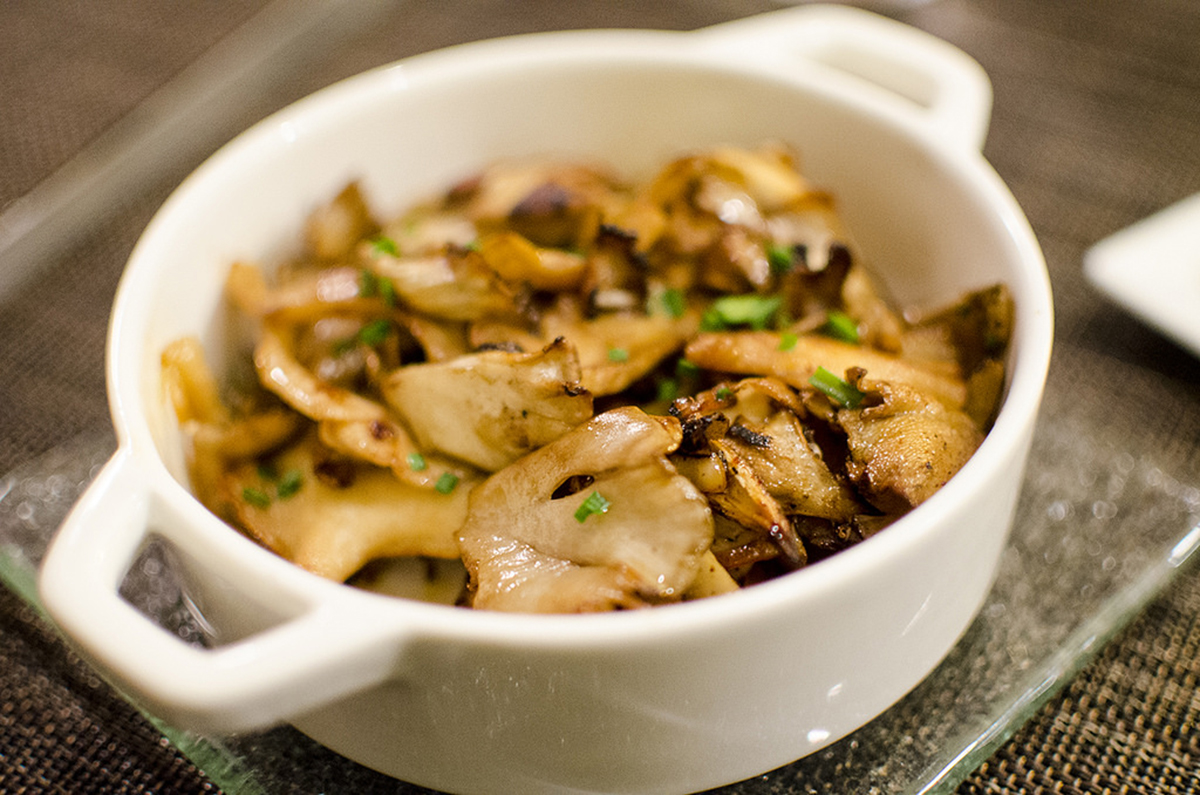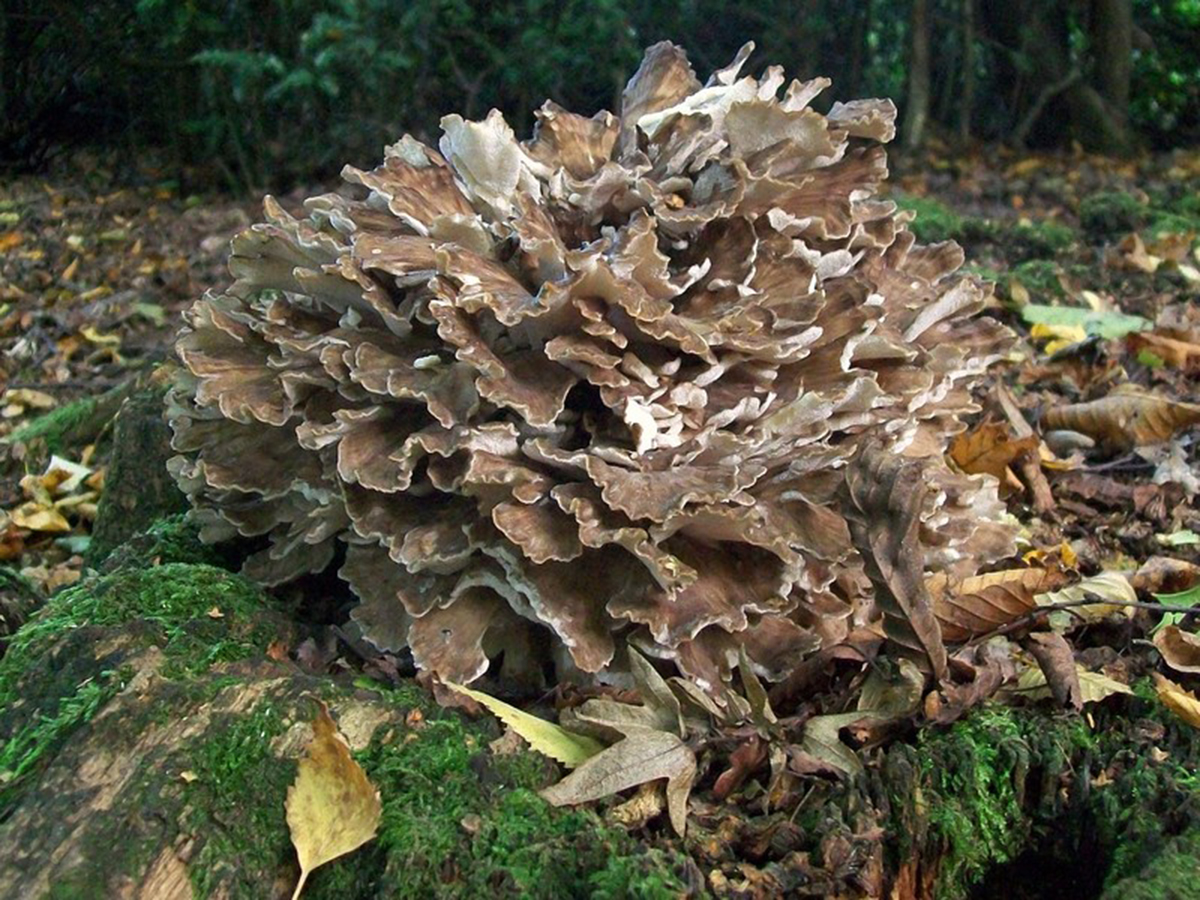"That one makes a fine meal," a mushroom expert told us while we were walking through the woods. We enjoy the occasional nature walk and have played around with foraging just a little bit, though nothing much more adventurous than dandelions and apples. I've always been weary of picking wild mushrooms however, as they're notoriously difficult to differentiate to the untrained eye and even to the supposedly trained eye. A self-proclaimed mushroom connoisseur from my home town died after eating the wrong fungus. Nuff said, really.

Still, I was intrigued. The mushroom in question grows at the base of trees, and it's especially fond of oak trees. It's called Grifola Frondosa, and is additionally known as hen-of-the-woods, ram's head, and sheep's head among English speakers. Its Japanese name, maitake, is also gaining popularity. Maitake means "dancing mushroom". Looking at it, you can see why. Its elegant lines look like a dance, though some say this is the dancing mushroom because someone who finds it in the woods ought to do a happy dance.
What's So Special About Maitake?
Maitake, or whatever other name you prefer to call this fungus by, is used in Traditional Asian Medicine to boost the immune system. If you are a non-skeptical alternative health nut, you might believe it's good for next to everything that you be wrong with you. Some say the hen-of-the-woods can be used to prevent cancer, contribute to treating cancer, and lessen the side effects of chemotherapy. It's also said to regulate blood pressure and blood sugar levels, help prevent and heal flu, colds, herpes outbreaks, uterine fibroids, and allergies. Indeed, some alternative health blogs say that maitake can be useful as (a part of) HIV treatment. Grifola Frondosa has been promoted as a weight-loss aid as well.
Small-scale studies have been conducted into the anti-cancer properties of this mushroom, but consumers should be cautious and skeptical. The US Food And Drug Administration (FDA) has warned consumers to stay away from unregulated products that claim to help cure cancer, and has repeatedly sent out warning letters to companies selling maitake supplements while also claiming they could help cure cancer and other serious diseases.
See Also: Shiitake Mushrooms: a Powerful Immune System Booster
The mushroom is, however, rich in vitamins and minerals. It contains potassium, calcium, magnesium, vitamins B2, D2 and niacin, dietary fiber, and amino acids. While the presence of maitake is bad news for the tree on which it grows, it certainly has nutritional benefits that should make many people happy to include it in their diets. Grifola Frondosa isn't just pretty and healthy either. It's tasty and versatile — and if those are not among the most important attributes of a food, I don't know what would be.
If the mushroom grows on a tree near you — and that may well be the case — you may decide to get adventurous and harvest it for your own use. Its distinctive features make doing so relatively low-risk, in other words there aren't any highly poisonous mushrooms that look just like maitake.
Those who are scared of picking wild mushrooms may be happy to hear that maitake is commercially grown as well, allowing you to enjoy its taste and nutritious benefits without being scared you picked the wrong thing.
Where To Find Maitake, And How To Prepare It
Hoping To Find Grifola Frondosa In The Wild?
Maitake grows in Asia, Europe and America, in clusters around the base of trees. Oak trees are Grifola Frondosa's main host. Maple, elder, chestnut and elm trees can also host the fungus, though not as often.

It is a perennial that you can find it throughout the year in some places, dependent on the climate. The fungus does require particular temperature conditions — it should be between 5 and 37 degrees Celsius. You may still find maitake in hotter or colder conditions, but you won't want to take it home and cook it.
When fully grown, Grifola Frondosa can reach a respectable size of half a meter or more. Some maitake have been found to weight more than 20 kilos! Smaller ones can also be found. These are younger and tasty, but if you're sure nobody else will harvest "your" fungus, you could also decide to let maitake grow a little bigger. The fungus should be fresh and firm, not mushy and horrible. It should have a mild nutty smell to it, rather than an unpleasant rodent urine odor. It is best not to wash the fungus you choose under a tap. Clean it with a tissue or brush it with a mushroom brush (yes, they exist!), visually inspecting its body for bugs and other unwanted "spices". Since maitake has so many curvy bits, you'll want to make sure you inspect it thoroughly.
Are you less adventurous? Go look for maitake at farmers' markets, health food stores, or Asian markets. Though these mushrooms are commercially available in some places, locating a store that sells them might be just as hard as finding maitake in the wild.
Maitake Meal Ideas
I'm vegetarian, but meat eaters compare the structure to chicken, but say the taste is more flavorful.
See Also: Protein Rich Foods For Vegetarians
I've fried maitake in extra virgin olive oil with onions and garlic and topped with freshly cut spring onions and ginger. You could drizzle it with soy sauce and serve it with noodles or rice. You could also make your hen-of-the-woods part of a stir fry with many vegetables. An Indian-style curry also does perfectly well with some maitake in it. We've used curry sauces that do nicely with chicken (such tikka massala or madras) in this way with delectable results. You can also go Italian, and serve maitake over pasta with a creamy cheese sauce, or serve maitake on bruschetti. Or you could make a creamy soup with hen-of-the-woods, along with leek and potatoes, and perhaps carrots.
- Photo courtesy of Stephanie by Flickr: www.flickr.com/photos/sbogdanich/14207550883
- Photo courtesy of Peter aka anemoneprojectors by Flickr: www.flickr.com/photos/anemoneprojectors/5169557976


Your thoughts on this